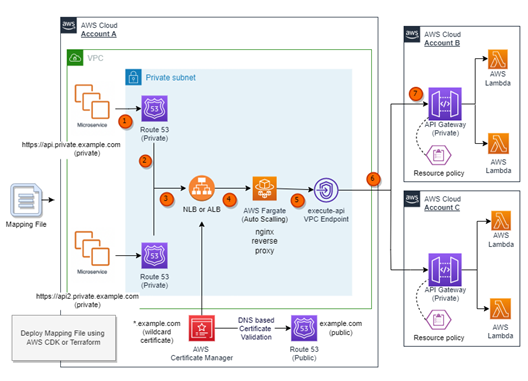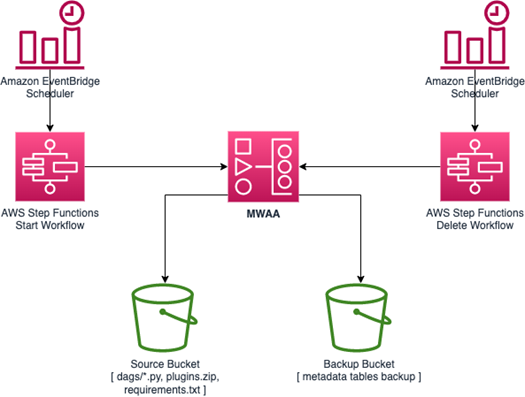AWS Compute Blog
Tag: serverless
Deploying state machines incrementally with versions and aliases in AWS Step Functions
This post is written by Peter Smith, Principal Engineer for AWS Step Functions This blog post explains the new versions and aliases feature in AWS Step Functions, allowing you to run specific revisions of the state machine instead of always using the latest. This allows for more reliable deployments that help control risk, and provide […]
Ruby 3.2 runtime now available in AWS Lambda
Get started building with Ruby 3.2 today by making necessary changes for compatibility with Ruby 3.2, and specifying a runtime parameter value of ruby3.2 when creating or updating your Lambda functions.
Implementing custom domain names for Amazon API Gateway private endpoints using a reverse proxy
This blog post demonstrates a solution that allows customers to utilize their private endpoints securely with API Gateway across AWS accounts and within a VPC network by using a reverse proxy with a custom domain name. The solution offers a simplified approach to manage the mapping between private endpoints with API Gateway and custom domain names, ensuring seamless connectivity and security.
Developing a serverless Slack app using AWS Step Functions and AWS Lambda
This blog was written by Sam Wilson, Cloud Application Architect and John Lopez, Cloud Application Architect. Slack, as an enterprise collaboration and communication service, presents opportunities for builders to improve efficiency through implementing custom-written Slack Applications (apps). One such opportunity is to expose existing AWS resources to your organization without your employees needing AWS Management […]
Automating stopping and starting Amazon MWAA environments to reduce cost
This was written by Uma Ramadoss, Specialist Integration Services, and Chandan Rupakheti, Solutions Architect. This blog post shows how you can save cost by automating the stopping and starting of an Amazon Managed Workflows for Apache Airflow (Amazon MWAA) environment. It describes how you can retain the data stored in a metadata database and presents […]
Monitor Amazon SNS-based applications end-to-end with AWS X-Ray active tracing
This post is written by Daniel Lorch, Senior Consultant and David Mbonu, Senior Solutions Architect. Amazon Simple Notification Service (Amazon SNS), a messaging service that provides high-throughput, push-based, many-to-many messaging between distributed systems, microservices, and event-driven serverless applications, now supports active tracing with AWS X-Ray. With AWS X-Ray active tracing enabled for SNS, you can […]
Debugging SnapStart-enabled Lambda functions made easy with AWS X-Ray
This post is written by Rahul Popat (Senior Solutions Architect) and Aneel Murari (Senior Solutions Architect) Today, AWS X-Ray is announcing support for SnapStart-enabled AWS Lambda functions. Lambda SnapStart is a performance optimization that significantly improves the cold startup times for your functions. Announced at AWS re:Invent 2022, this feature delivers up to 10 times faster function startup times for […]
Implementing cross-account CI/CD with AWS SAM for container-based Lambda functions
Containerized applications often have several distinct environments and accounts, such as dev, test, and prod. An application has to go through a process of deployment and testing in these environments. One common pattern for deploying containerized applications is to have a central AWS create a single container image, and carry out deployment across other AWS accounts. To achieve automated deployment of the application across different environments, customers use CI/CD pipelines with familiar container tooling. This blog post explores how to use AWS Serverless Application Model (AWS SAM) Pipelines to create a CI/CD deployment pipeline and deploy a container-based Lambda function across multiple accounts.
Extending a serverless, event-driven architecture to existing container workloads
The blog explains a way to integrate existing container workload running on AWS Fargate with a new event-driven architecture. You use EventBridge to decouple different services from each other that are built using different compute technologies, languages, and frameworks. Using AWS CDK, you gain the modularity of building services decoupled from each other.
Patterns for building an API to upload files to Amazon S3
This post explores three different approaches to securely upload content to an Amazon S3 bucket via HTTPS without the need to build a dedicated API or client application.









